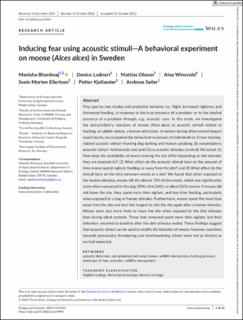| dc.description.abstract | Prey species may display anti-predatory behavior, i.e., flight, increased vigilance, and decreased feeding, in response to the true presence of a predator or to the implied presence of a predator through, e.g., acoustic cues. In this study, we investigated the anti-predatory reactions of moose (Alces alces) to acoustic stimuli related to hunting, at saltlick stones, a known attractant. In before-during-after-control-impact experiments, we compared the behavioral responses of individuals to: (i) two hunting-related acoustic stimuli—hunting dog barking and human speaking; (ii) nonpredatory acoustic stimuli—bird sounds and; and (iii) no acoustic stimulus (control). We asked: (1) How does the probability of moose leaving the site differ depending on the stimulus they are exposed to?; (2) What affect do the acoustic stimuli have on the amount of time moose spend vigilant, feeding, or away from the site?; and (3) What affect do the stimuli have on the time between events at a site? We found that when exposed to the human stimulus, moose left the sites in 75% of the events, which was significantly more often compared to the dog (39%), bird (24%), or silent (11%) events. If moose did not leave the site, they spent more time vigilant, and less time feeding, particularly when exposed to a dog or human stimulus. Furthermore, moose spent the most time away from the site and took the longest to visit the site again after a human stimulus. Moose were also more likely to leave the site when exposed to the bird stimulus than during silent controls. Those that remained spent more time vigilant, but their behaviors returned to baseline after the bird stimulus ended. These findings suggest that acoustic stimuli can be used to modify the behavior of moose; however, reactions towards presumably threatening and nonthreatening stimuli were not as distinct as we had expected. | |
